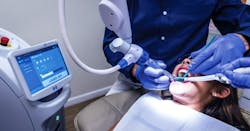Clinical laser treatment hardens tooth enamel, reduces decay
Patients often have well-founded misgivings about novel therapeutic or prophylactic techniques—no one wants to be the guinea pig if it can be avoided. There is one notable exception: laser devices. Lasers seem not only to be quickly accepted, but even sought after.1 Fortunately, lasers often live up to their reputation, as in preventive dentistry, where preliminary results have indicated that several laser wavelengths can effectively improve the acid resistance of tooth enamel.2, 3 A recent clinical study now confirms the prophylactic effect of an additional laser treatment: 9.3-µm laser-assisted remineralization.4
Enamel on the surface of the tooth serves as a primary barrier to decay, also known as dental caries. Enamel consists of hydroxyapatite, an acid-resistant mineral. Unfortunately, a significant number of native phosphate groups are typically substituted with carbonate ions, creating carbonated hydroxyapatite (CHA), a significantly less acid-resistant material. This is undesirable, because bacterial colonies in the mouth secrete acid. In the presence of bacterial plaque, vulnerable CHA decays, with unpleasant consequences for oral health.
Lasers to the rescue
When CHA is heated, the carbonate is driven out, allowing phosphate groups to reintegrate in the enamel. If CHA is heated in the presence of fluoride, fluoride ions create fluorapatite, which has even higher acid resistance than native enamel. For several decades, it has been known that lasers provide a convenient and efficient method of delivering energy to tooth enamel. Additional studies have been aimed at determining the optimal laser-beam parameters to maximize the beneficial remineralization and minimize heating of the sensitive central pulpal tissue. Professor Peter Rechmann and his colleagues at the University of California-San Francisco have just completed a study that takes the work one step further. They performed a year-long clinical study of the protective effect of one of the secondary wavelengths of CO2 laser irradiation.
The study followed 51 adolescent and pre-adolescent children, from 10 to 16 years old, for a year following the initial treatment. Approximately 90% of the decay in children’s permanent teeth occurs in pits and fissures—narrow clefts in the contact surfaces of the teeth. Rechmann’s team randomly selected either a left or right and upper- or lower-jaw second molar to receive laser treatment on those contact surfaces, with the second molar on the opposite side serving as the control. The teeth were examined at the beginning of the clinical trial and classified with three different metrics for dental health. Any participants with existing cavities were excluded from the study.
The contact surfaces of the teeth were treated with at least 20 4 µs, 1.9 mJ pulses of 9.3 µm laser light. No air or water cooling spray was used. All the teeth were then coated with fluoride varnish. The participants were then re-examined at six months and then one year after the initial treatment.
The International Caries Detection and Assessment System (ICDAS) rating is a standard, although partially subjective, measure of tooth decay. A score of zero represents no signs of decay, with higher scores corresponding to higher degrees of decay. A score of three, for example, indicates the presence of a cavity. At six months, more than half the control teeth exhibited a worse ICDAS score, while nearly 80% of the laser-treated teeth either had the same ICDAS score, or even improved. After a year, 75% of the control teeth had worsened, while 75% of the laser-treated teeth had either stayed the same or improved. The other two measures of dental health showed consistent results.
Speaking about this work at SPIE’s BiOS Conference in March 2020, Rechmannn said, “The results are amazing…on caries, it really works…even in the clinics, because sometimes you see stuff working in a lab, not in the clinic.”
Refinements and improvements
Concurrently but independently, Rechmann’s group has also been working to improve the laser exposure protocol.5 The commercially available 9.3 µm laser, for example, has a hotspot, which makes it more likely that a surface treatment will melt local regions of the enamel. Although melting appears to have no deleterious effects on dental health, it does slightly change the appearance of the tooth, so the group inserted a beam spreader in the optical path. The modification eliminated the hotspot. In tests with extracted teeth, however, the modified beam still retained the ability to remineralize tooth enamel and—with or without fluoride—enhance acid resistance.
In other work on extracted teeth, presented at BiOS 2020 in February 2020, Rechmann demonstrated that exposure to 9.3 µm radiation, in conjunction with an amine fluoride/sodium fluoride/stannous fluoride solution, reduced erosion in an acidic environment.6 Even better, Rechmann noted, “It appears that over time even remineralization is enhanced, and the average mineral loss is significantly reduced.”
REFERENCES
1. R. Sarmadi et al., Int. J. Dent. Hygiene, 12, 67–73 (2014).
2. H. G. D. Boari et al., Laser Phys., 19, 1463–1469 (2009).
3. V. Takate et al., J. Int. Soc. Prev. Community. Dent., Jan-Feb; 9, 1, 47–54 (2019).
4. P. Rechmann et al., Clin. Oral Investig. (Aug. 15, 2020).
5. P. Rechmann et al., Lasers Med. Sci. (Jan. 3, 2020).
6. P. Rechmann et al., Proc. SPIE, 11217, 1121702 (Mar. 9, 2020).
About the Author
Richard Gaughan
Contributing Writer, BioOptics World
Richard Gaughan is the Owner of Mountain Optical Systems and a contributing writer for BioOptics World.

